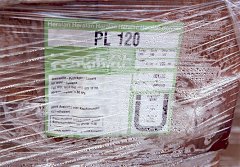Section 10.3.7 listed loss prevention measures for avoiding moisture damage in container transport, including:
- The concept of container dry goods, packaging, accompanying material and dunnage
- Perforated packaging
- Fungicides
- Mold caused by water-soluble adhesives
- Covering with paper dunnage to protect against sweat
- Covering with plastic sheets with condensation reservoirs to protect against sweat
- Suspension in a standard container of a nonwoven fabric
- Suspension in a standard container of a liner bag for bulk cargo
- Stripping of hygroscopic goods in winter
- Sealed packaging for high-quality machinery
- Pros and cons of the desiccant method
- Use of ventilated containers for high-quality agricultural products (green coffee beans)
Some more notes on the above follow below.
- The most important prerequisite for loss-free transport in a standard container is for the cargo, its packaging, dunnage and accompanying material to be introduced into the container in a container dry state.
It should be pointed out, however, that the cargo must not be dried to a level too far below the recommended lower water content limit, as this is associated with loss of aroma and thus odor and flavor impairment, especially in sensitive foodstuffs and semiluxury items such as green coffee beans, raw cocoa and leaf tobacco. For instance, bay leaves take on a hay-like flavor, become brittle and finally turn to dust.
- Packaging, for example cartons, plastic bags, should be perforated. Although in Fig. 59 (rock wool) the packaging carries the indication that the product has been hydrophobed, i.e. rendered water-repellent, a large quantity of sweat has formed inside the plastic bag, which is unable to escape due to the lack of ventilation holes.
 |
Figure 59: Sweat inside an unperforated plastic bag |
- No fresh or wet lumber should be used in case construction. The same applies if lumber is used for cargo securing measures. The optimum water content for lumber deemed to be container dry lumber is 12 - 15% (air dry lumber), the equilibrium moisture content being 70 - 80% at 20°C (see Section 19.1).
However, "semi-dry" lumber, i.e. with a water content < 30%, is used in practice. Mold growth is to be expected at a water content of > 20%.
- The corrosion protection provided by the desiccant method is ineffective if the sealed package is damaged. Therefore, all sharp-edged or pointed parts of the package contents and the case bottom have to be padded.
- The respiration intensity of respiring hygroscopic goods, such as legumes, seed, oil-bearing seeds/fruits, is stimulated by elevated water contents or elevated temperatures. Random measurements of the water content of the product and its packaging must therefore be made prior to packing of the container.
- This also applies to compliance with the rules relating to the stowing together of different goods: no goods with a high water content should be stowed together in a container with moisture-sensitive goods.
- Prior to packing, it is important to inspect the container: dry floor covering, tightly closing doors, no holes or cracks (visual inspection with closed container door). When packing the container, attention must be paid to the relative humidity and temperature of the packing shed (storage location): relative humidity should not exceed 60%.
- At winter temperatures, the containers should where possible be packed in a warehouse and/or suitable measures should be taken to reduce relative humidity in heated warehouses.
|
